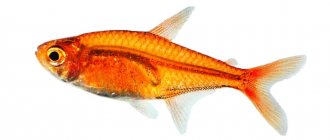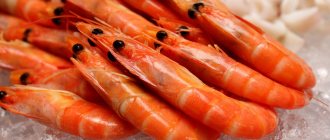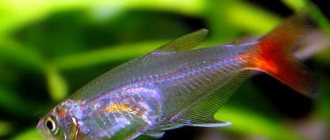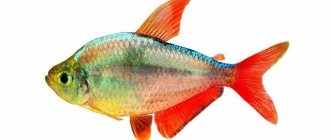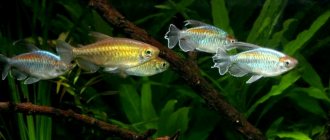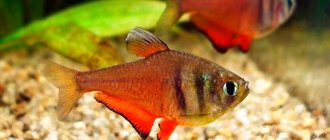Royal tetra (Nematobrycon palmeri) Eigenmann, 1911.
It was discovered by the American collector Palmer and described in 1911 by the American ichthyologist Eigenmann. It entered European aquariums in 1959 and was brought to our country in 1965.
Synonyms
Russian: Tetra palmeri, Imperial tetra Latin: Nematobrycon amphiloxus
Family: Characinaceae Genus: Nematobrikon
Range and Habitat
South America: endemic to the San Juan and Atrato river basins in Colombia, typical habitats of the Rio Condoto and Novita rivers, Rio Tamana, southwestern Colombia.
They come from forest streams, small tributaries and creeks, and inhabit areas with weak currents.
Description
The body is elongated, slightly flattened laterally, the dorsal line is strongly arched. The jaws are short, the teeth are clearly visible.
The body color is pinkish-brown with a purple or bluish tint, the belly is cream. The fins are transparent with a greenish-yellow tint. A black stripe stretches from the snout to the tail with a clear upper contour and a blurred lower contour. The sides below the line are dark blue. The anal fin has a black line and a yellow edging along the edges. The outer rays of the tail, the braid and the first ray on the dorsal fin are black. She has a very expressive eye color - emerald blue.
The caudal fin has a unique, very characteristic three-lobed shape, which is given to it by long central rays. The first rays on the dorsal fin are saber-shaped. The adipose fin is absent.
Size:
Males are up to 50 mm long, females are slightly smaller.
Differences between a male and a female
Males are larger and display a greater variety of colors, while females are paler and have a more rounded body. Males have wider dorsal, anal and caudal fins as adults. The central ray of the caudal fin is strongly elongated. The iris of the eyes of the male is blue, in females it is green.
Male
Female
Behavior and Compatibility
It is preferable to keep them in groups of 5 or more individuals with a predominance of females.
This is an active and peaceful fish whose colors provide a pleasant contrast to those of many other species. An excellent addition to a community aquarium containing other peaceful fish. Compatible with calm and small characin and carp fish species. Apistogramma and other dwarf cichlids, peaceful bottom dwellers such as corydoras or smaller loricariids, are suitable for keeping together.
Territorial, there is always a dominant male in the group, occupying the largest territory. Protecting their possessions, males swim slightly leaning forward, their tail raised 45 degrees at this moment looks like a crown.
A schooling species, so buy as many as possible from 10 or more, since with this number the fish are more active and less timid, more often visible and have better coloring, and exhibit more natural behavior.
Aquarium
An aquarium with basic dimensions of 90 * 30 cm or equivalent; to keep a small group you will need an aquarium of 80 liters or more.
The coloring is best seen against the background of dark soil, snags and islands of dense vegetation. In addition to areas free for swimming, the aquarium should have densely planted areas. Vallisneria, Echinodorus, Aponogeton curly, Cryptocoryne, and Thai fern are well suited for this. Floating plants are used to create muted and diffused lighting.
The aquarium must have a lid, the fish are jumping.
Water parameters:
Temperature: 23 - 27° C pH: 5.0 - 8.0 Hardness: 5 - 19° dGH
Water changes, about 25%, are carried out regularly. It is advisable to add peat extract.
Breeding
It can breed both in a separate and in a general aquarium. Spawning can be in pairs, but it is better to plant spawners in a ratio of two females and one male.
A separator net and small-leaved plants are placed in a 20-liter spawning aquarium. The water level is about 15 cm.
Water parameters in the spawning tank: water should be soft and acidic in the range of 26-28° C, dH 4-8, pH 6-6.8.
To stimulate spawning, spawners are kept separately for two weeks; their diet is predominantly live and frozen food.
The productivity of the female is small, up to 150 eggs. Parents are removed immediately after spawning. The water level decreases to 7-10 cm, and the aquarium is darkened.
The eggs are incubated for 1-2 days, the juveniles swim and feed on days 4-6. At first, the fry take ciliates and rotifers. As the Artemia nauplii grows.
At one month of age, a dark longitudinal stripe appears; a week earlier, they begin to swim obliquely, which is typical for adult fish.
Life expectancy in an aquarium is about 5 years.
Reproduction
Fish become sexually mature around eight months. A spawning tank will be required, since the parents eat their eggs after laying. Create diffuse lighting in the tank, add more plants and algae with small leaves. Spawning will occur on them.
You can lay a coarse mesh on the bottom so that the eggs fall through it to the very bottom. Then the fish will not be able to reach them.
Recommended water parameters:
- temperature about 27 C;
- hardness 2-6 dH;
- acidity 5-7 pH.
A powerful filter and aeration device is also necessary. Professionals advise adding oak or alder broth to the water.
For spawning, you can use either a pair or a small flock of different-sex individuals. Producers begin to intensively fatten with live food in advance. On such a diet, females quickly become rounder. The fish are moved in the evening, and the spawning process usually starts in the morning. To do this, the males begin to whip them on the stomach with their tails so that the eggs come out.
Sometimes spawning is delayed for several days. This is due to the increased timidity of females, who strive to constantly hide from overly aggressive attacks by males. So spawning lasts no more than 2 hours. Upon completion, the parents are immediately removed.
The fry begin to move independently after 6 days. At this time, they must be fed with ciliates or live dust. Then the juveniles are gradually transferred to the adult diet. By the age of one and a half months, they grow up to 2 cm in length and acquire adult coloration.
Sex differences
Males stand out among the general composition with their large but graceful forms. Females are quite clumsy in this regard. In addition, males shimmer more intensely and have longer, more voluminous fins. Ladies are endowed with a less flashy cover.
The diamond tetra is an extremely schooling fish. A long and healthy life is guaranteed only when they are kept in groups of 7-8 individuals, where there are female and male individuals in equal numbers
“Diamonds” attract attention not only with their brilliance, but also with their interesting habits. Thus, males like to periodically stop in place, thereby demonstrating their attractiveness
In general, the fish are active and constantly hungry.
Notes
This species can be found in most retailers' aquariums and is one of the best options for beginners in the aquarium hobby, being attractive, hardy and inexpensive. Since almost all fish are raised in captivity, they are usually relatively unpretentious in terms of water chemistry and nutrition.
It is sometimes confused with Tetra lecorte (Nematobrycon lacortei), which is currently the only other species in the genus. They can easily be distinguished from each other by looking at the eye of the fish in question, as the male N. lacortei has a bright red iris in contrast to the blue one of the male N. palmeri.
The "blue" or "purple emperor tetra" Inpaichthys kerri is also often misidentified as N. palmeri. Although this species not only belongs to a different (monotypic) genus, its fins are also much smaller in size and without extensions. Kerry also possesses an adipose fin, which is absent in nematobrycones.
In recent years there has been controversy over the existence of a third species of nematobrycon, N. amphiloxus, which has a much greater proportion of dark body patterns and is commonly sold as the "black emperor tetra". Currently, most experts believe that this is a color transformation of N. palmeri. There is also a golden form.
Feeding
Despite their peaceful disposition, these tetras are predators. In nature, they feed mainly on invertebrates, small insects that live or accidentally find themselves in the water and their larvae, worms and crustaceans.
In captivity, fish can easily content themselves with almost any food:
- dry flakes;
- artemia;
- bloodworm;
- pipe maker, etc.
When feeding fish, it is important to pay attention to the appearance of the food, because due to the anatomical features of the stigma, they cannot pick up food from the bottom. When using commercial dry food, it is better to give preference to slow-sinking flakes; it is better to give live food through a special feeder, and hand-feed when defrosted.
It must be kept in mind that fish with veil fins often awaken their hunting feeding instincts, and then tetras tend to bite them.
Black color variation.

